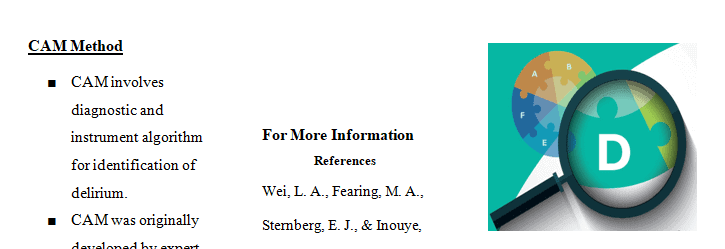Promote evidence-based decision making and effective communication to improve nursing practice in a variety of settings
The information and activities in this Module will assist you in meeting the following Course Objectives (CO) and Student Learning Objectives (SLO):
Demonstrate the ability to promote evidence-based decision making and effective communication to improve nursing practice in a variety of settings. (Course Objectives 4 and Student Learning Outcomes 2,3,4, and 5)
Develop a flyer that will encourage staff to attend a presentation addressing information about your PICOT question and proposed changes to professional practice and decision-making including the evidence obtained during your search of four (4) articles (Course Objectives 4 and Student Learning Outcomes 2, 3, 4, 5)
Summarize the information obtained from four (4) research articles about a concern or issue in clinical practice with peers. (Course Objectives 4 and 5 and Student Learning Outcomes 2, 3, 4, and 5
The purpose of the educational flyer is to inform staff members on your unit concerning a clinical practice update or other contemporary issue associated with clinical practice based on the information you obtained from your PICOT question.
The flyer will either advertise a presentation of the information learned in your research orprovide a summary of the information you obtained in your research and how it can be used in practice. The flyer will offer information to staff in an interesting colorful format containing information about the time, place, and length of the presentation as well as specific staff members that should attend (PCAs, RNs, Team leaders, etc) or pictures and a summary of the information and how it can be used on the unit or in practice. Rubric for Educational Flyer
5 minute Video of Flyer Example
The flyer should be 2 pages in length and will be posted in the discussion forum for peers to review and comment on the flyer. Use APA formatting with in-text citations and at least 4 references that are less than 5 years old. Please refer to the rubric for more details.
Brochure that educates on the confusion assessment method
In the mechanically ventilated patient is spontaneous awakening trials (SAT) with the confusion assessment method for intensive care unit (CAM-ICU) patients compared with not using CAM-ICU more accurate in diagnosing ICU delirium? In the intensive care unit, the nurse initial assessment requires turning down sedation to perform a more accurate neurological assessment. In my Department I was not taught the confusion assessment method during my orientation. My preceptor would assess neurological status by asking the patient to perform certain tasks such as squeeze their hands, wiggle their toes, or questions that they would nod yes or no to assess for whether the response was correct. There was no consistency across the board as to nursing staff doing proper CAM-ICU assessments. I did later discover after being on the unit for about six months that CAM-ICU assessment was to be a part of our initial assessment. However, I did begin working the unit at the beginning of the pandemic, so maybe that\’s why I didn\’t learn proper technique initially. Concerns that arose with the use of CAM-ICU assessment was why there was no consistent use of the method among the nurses in the unit. It would only be used when the patient exhibited bizarre behavior. I also pondered if nurses knew how to properly use the method.
There were many articles on CAM-ICU, varying from quality improvement, evidence based practices and nursing research. Use of the CAM-ICU during daily sedation stops in mechanically ventilated patients as assessed and experienced by intensive care nurses –related more to quality improvement because its aim related to the nurses experiences with the method.
Else, B. S., Høye, S., & Hov, R. (2018). Use of the CAM-ICU during daily sedation stops in mechanically ventilated patients as assessed and experienced by intensive care nurses – A mixed-methods study. Intensive & Critical Care Nursing, 47, 23-29. doi:http://dx.doi.org/10.1016/j.iccn.2018.04.005
Nieswiadomy, R. M., & Bailey, C. (2017). Foundations of nursing research (7th ed.). Pearson.
Answer preview to promote evidence-based decision making and effective communication to improve nursing practice in a variety of settings

352 words

